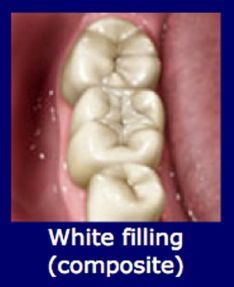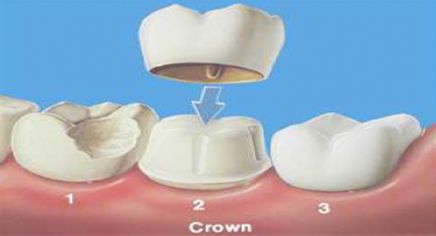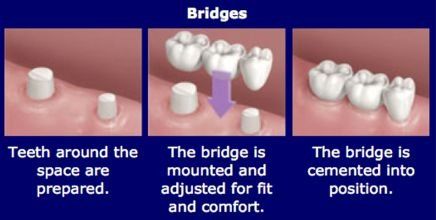Services
Crowns, Veneers & Bridges
What Are Crowns and Bridges?
Both crowns and most bridges are fixed prosthetic devices that bind to the teeth. A crown is used to entirely cover or "cap" a damaged or discoloured tooth.It is advised to strengthen a damaged,weakened or broken tooth, a crown can be used to improve its appearance, shape ,colour or alignment. A crown can also be placed on top of an implant to provide a tooth-like shape and structure for function. Crown and bridges can be made of porcelain, gold alloy or both.
How Do Bridges Work?
A bridge is recommended to replace one or more missing teeth. Gaps left by missing teeth eventually cause the remaining teeth to rotate or shift into the empty spaces, resulting in a bad bite. The imbalance caused by missing teeth can also lead to gum disease and temporomandibular joint (TMJ) disorders. Bridges are commonly used to replace one or more missing teeth. They span the space where the teeth are missing. Bridges are cemented to the natural teeth or implants surrounding the empty space.
How Are Crowns and Bridges Made?
Before either a crown or a bridge is made, the tooth (or teeth) is reduced in size so that the crown or bridge will fit over it properly. After reducing the tooth/teeth, an impression is taken to provide an exact mold for the crown or bridge. Using this impression, a dental lab then makes your crown or bridge, in the material your dentist specifies. A temporary crown or bridge will be put in place to cover the prepared tooth while the permanent crown or bridge is being made. When the permanent crown or bridge is ready, the temporary crown or bridge is removed, and the new crown or bridge is cemented over your prepared tooth or teeth.
Veneers
Veneers are recommended for Smile make over.Veneers are thin layer of restorative materials placed on top of the teeth for aesthetic and cosmetic improvement.They are generally used to mask discoloured teeth ,minor fractures,close minor gaps between teeth, smile improvement.They are made of two materials composite or porcelain.
Root Canal Treatment
Root canal treatment is the removal of the tooth's pulp tissue in the center of the tooth. Then the remaining space is cleaned, shaped and filled. This procedure seals off the root canal. root canal treatment saves many teeth that would otherwise be lost.
The most common causes of pulp damage or death are:
- A cracked tooth
- A deep cavity
- An injury to a tooth, such as a severe knock to the tooth, either recent or in the past.
Once the pulp is infected or dead, if left untreated, pus can build up at the root tip in the jawbone, forming an abscess. An abscess can destroy the bone surrounding the tooth and cause pain
How is a Root Canal Done?
Root canal treatment is a sensitive and needs several visits. First, an opening is made through the back of a front tooth or the crown of a molar or pre-molar. After the diseased pulp is removed the pulp chamber and root canals are cleaned, enlarged and shaped in preparation for being filled. Temporary filling is placed in between the visits. The temporary filling is removed and the pulp chamber and root canal permanently filled with a , rubbery material called gutta-percha is inserted into each of the canals and is often sealed into place. Crown is advised to strengethen the brittle root canal treated tooth.
Fillings
Gum Disease
What causes Gum Disease?
Gum disease is due to growth of bacteria in your mouth. This bacteria comes from the build up of plaque, a sticky colorless film that constantly forms on your teeth, and left unattended can lead to gingivitis. Gingivitis is the mildest form of periodontal disease. It produces toxins that can irritate gum tissue causing red, swollen gums that bleed easily and become very irritated,causes bad breadth,ocassionally pain. If left untreated, it could lead to mild or severe periodontitis which causes bone loss and loosening of teeth.it is a silent and asymptomatic disease in initial stages
What can I do to prevent gum disease?
Start by brushing twice a day and flossing every day. Regular dental care is extremely important in helping to keep your mouth healthy. Visit dentists for routine care, especially cleaning, at least twice a year. Your dentist can remove hardened plaque and any tartar that you're not getting to with brushing or flossing.
If your dentist determines that you have some bone loss or that the gums have receded from the teeth, the standard treatment is an intensive deep-cleaning, non-surgical method called scaling and root planing (SRP). Scaling scrapes the plaque and tartar from above and below the gum line. Root planing smoothes rough spots on the tooth root where germs collect and helps remove bacteria that can contribute to the disease. This smooth, clean surface helps allow the gums to reattach to the teeth.
Teeth Grinding
Teeth grinding is clinically referred to as bruxism. Simply defined, it is the act of consciously or unconsciously clenching your teeth either during the day or while you sleep. Bruxism is considered both a medical and a dental problem. This is because it affects both the teeth and all of the structure near it, including the head and cause problems like jaw pain,headaches, broken/worn/fracture teeth or generalised sensitvity.
It is very important for adults to consult a dentist so that their teeth grinding habit is addressed generally by making a SPLINT / GUARD to protect the teeth before any further problems develop.
Contact Information
Address
Macquarie Fields Dental Care - Shop 1 / 71 Saywell Rd, Macquarie Fields NSW 2564




